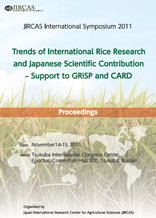Rice Production Technologies for Climate Change

Predicted levels of global warming will have a marked effect on the growth, yield, and quality of the crop.
A number of experimental and simulation studies have been conducted to determine or predict the likely
impacts of climate change on yields of major crops, including rice (Oryza sativa. L), the most important food
crop in Asia. A summary of these simulation results by the Intergovernmental Panel on Climate Change
indicated that the effects of climate change on crop yields will be different depending on the region or the
current level of temperature. In low-latitude regions, crop yields may drop even with a 1 °C increase in air
temperature from the current level. In mid-high latitude regions, negative effects of climate change may
appear where air temperature rises by 3 °C or more. However, these predictions include large uncertainties not
just in a magnitude but in the direction of the impacts.
The uncertainties in the predictions resulted from a number of sources, such as those in the carbon
emission scenarios, global climate models and gaps between global and local climates. Options in land use,
crops, varieties and management practices may also make climate change impacts very different. In addition,
crop models themselves contain uncertainties. Many of the crop models were developed based on small-scale
experiments typically those conducted in environmental controlled chambers. While these experimental
results are highly valuable in understanding the mechanisms of crop responses to the environmental changes,
extrapolating to the field or regional conditions under variable climatic conditions creates another major
source of uncertainties in the prediction of the future crop production. Testing the climate change impacts on
crop production at the field or regional scale is still difficult and no single method can give us an overall
picture of the impacts. We need to combine knowledge obtained from different methods and at different
temporal and spatial scales to understand the likely impacts of climate change.
Both positive and negative effects of climate change are expected: Increasing atmospheric CO2
concentration will have a positive influence on crop growth and yield via promoting photosynthesis and
reducing the water use due to reduced stomatal conductance. Increases in temperature may reduce the low
temperature limitations on growth particularly in high-latitude and/or high altitude regions, but will shorten
crop life cycle and increase occurrences of heat stress and water use. Depletion of water resources and/or
changes in precipitation patterns may change crop calendar and the inter-season variability of crop production.
These counteracting effects will determine the magnitude and even the direction of the impacts of climate
change. Adaptation to climate change should there aim to reduce negative impacts of climate change and to
explore opportunities to enhance positive effects.
The projected climate changes will also affect carbon metabolism including methane emission from the
paddy field, which will further exacerbate global warming. Future rice agriculture will therefore face
challenges to meet increasing demand and to mitigate emission of green house gases from the agriculture
sector under changing climates.
How management opstions such as variety options, management options (eg water ane nitorgen) will
influence crop production/productivity and greenhouse gas emission from arable land is our central concern,
but agricultural practices are specific to the regions like the impacts of climate change. Climate change is the
common problem around world, but how you adapt to it is locally specific. In agricultural sector, there is no single and/or simple package solution readily transferable from one region to another. Adaptation/mitigation
measures should be “Tailor-made” and designing and evaluating options for each region are essential. To tailor
adaptation/mitigation measures, the following three components should be well coordinated ; (1) database of
climate, crop, soil and agricultural practices for monitoring changes in climate and crop production. (2)
mechanistic understandings of the climate change impacts on crops and various agro-ecosystems, (3) seeds of
adaptation/mitigation options or technologies. International collaboration across different climate zones and
different disciplines will facilitate this coordination.
| Date of issued | |
|---|---|
| Creator | Toshihiro Hasegawa |
| Subject |
Adaptation CO2 Mitigation Temperature Uncertainties |
| Publisher | Japan International Research Center for Agricultural Sciences |
| Available Online | |
| Issue | 2011 |
| spage | 152 |
| epage | 157 |
| Rights | Japan International Research Center for Agricultural Sciences |
| Language | eng |
